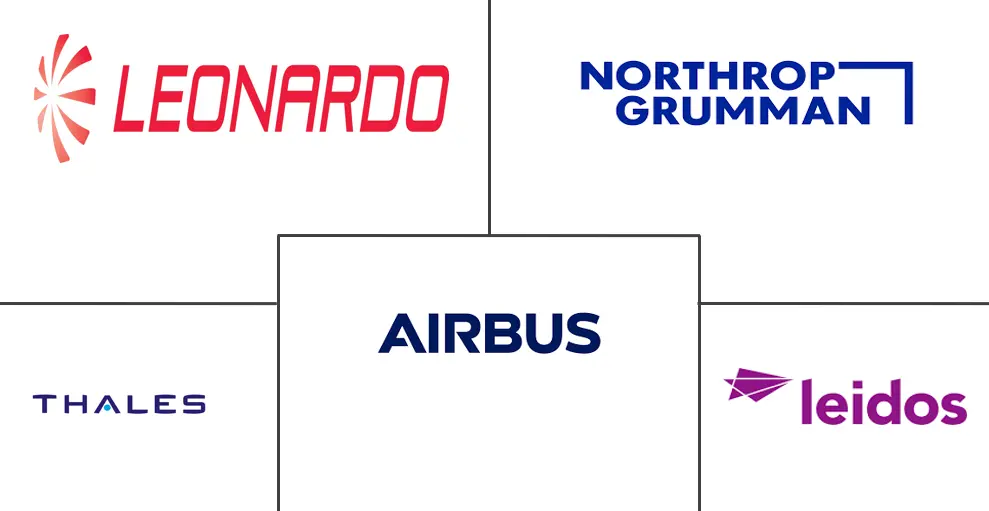Airborne ISR Market Size and Share
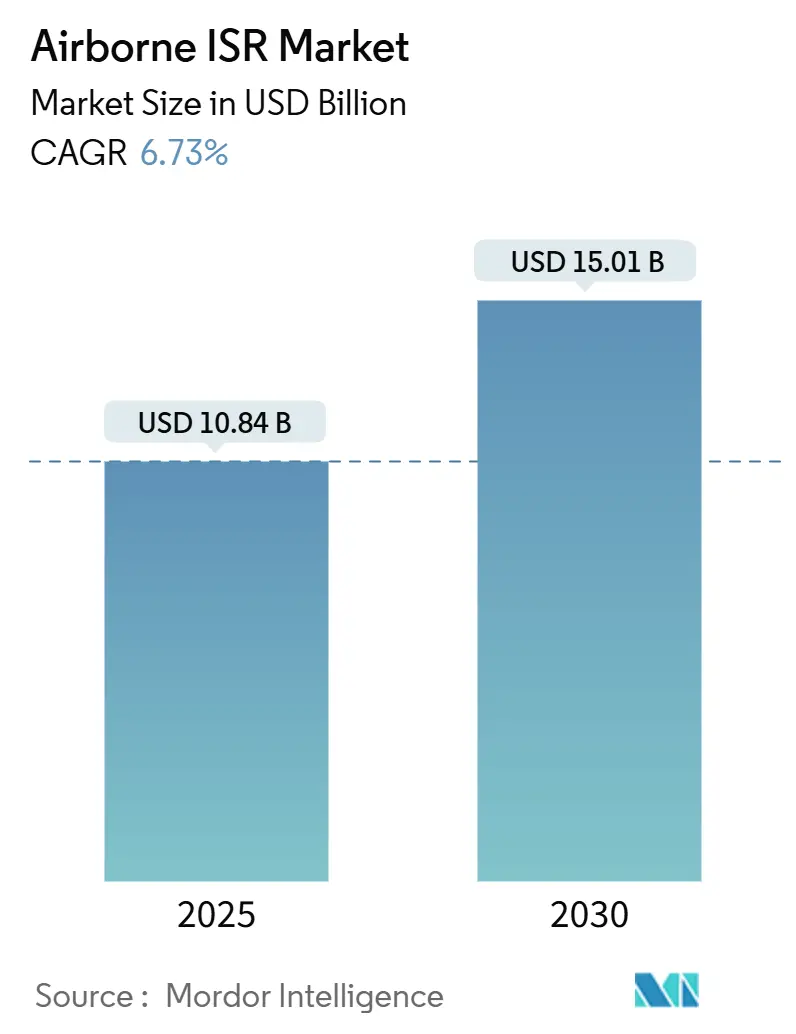
Airborne ISR Market Analysis by Mordor Intelligence
The Airborne ISR Market size is estimated at USD 10.84 billion in 2025, and is expected to reach USD 15.01 billion by 2030, at a CAGR of 6.73% during the forecast period (2025-2030).
Both military and civilian sectors worldwide are increasingly prioritizing real-time, actionable intelligence, leading to a surge in demand for advanced airborne intelligence, surveillance, and reconnaissance (ISR) systems.
The airborne ISR market is experiencing rapid technological advancements and strategic investments driven by geopolitical tensions, evolving battlefield requirements, and the need for real-time intelligence. Nations worldwide are modernizing ISR platforms across airborne, naval, space-based, and ground-based domains to improve situational awareness, target acquisition, and decision-making capabilities that drive market growth. Modern conflicts require integrated, multi-domain ISR systems that enable seamless data sharing across air, land, sea, space, and cyber domains. The United States (US), China, Russia, and NATO allies are investing in network-centric ISR architectures that combine AI, edge computing, and sensor fusion for enhanced intelligence processing.
Supply chain disruptions and a shortage of ISR components are stifling market growth. An intricate global supply chain comprising avionics manufacturers, sensor fusion developers, and radar technology suppliers support the production of ISR aircraft, UAVs, and airborne sensors. However, disruptions from the global pandemic, geopolitical tensions, and supply chain bottlenecks have limited the availability of high-performance ISR components, resulting in delayed program deliveries and increased costs.
Global Airborne ISR Market Trends and Insights
The Unmanned Segment to Experience Highest Growth During the Forecast Period
Driven by cost-effectiveness, global demand for unmanned aerial vehicles (UAVs) in ISR missions has surged. Increased defense spending and heightened acquisition of unmanned systems for ISR missions fuel the market's expansion. Major players, including the United States, Russia, and China, have reshaped military strategies, emphasizing UAV visual capabilities. Excelling in modern warfare, these UAVs play pivotal roles in pre-emptive strikes and targeted surveillance.
Nations, particularly those favoring asymmetric warfare, increasingly view UAVs as essential intelligence-gathering tools. HALE and MALE UAVs are transforming ISR operations, allowing nations to bolster their ISR UAV fleets. This expansion facilitates real-time battlefield surveillance, maritime reconnaissance, and border security monitoring. Seamlessly integrating AI-driven target identification, autonomous surveillance, and mission execution coordination, ISR UAVs are replacing traditional reconnaissance aircraft. The US's XQ-58 Valkyrie ISR UAV, with its AI-driven SIGINT and ELINT processing, ensures swift threat classification and bolsters hypersonic missile targeting. Meanwhile, China's GJ-11 Sharp Sword is advancing stealth ISR drone capabilities, harnessing AI for enhanced battlefield intelligence. Russia's S-70 Okhotnik UCAV not only boosts ISR-strike collaboration but also sharpens autonomous target tracking and decision-making in battlefield ISR.
For instance, in February 2025, at IDEX 2025, EDGE Group and Metal-Master showcased the Sinyar LAR3P, an ISR and combat drone, broadening their advanced UAV portfolio. Evolved from a commercial manned aircraft, the LAR3P melds AI-enhanced ISR capabilities with precision strike features, streamlining the sensor-to-shooter loop for swift battlefield targeting. Furthermore, in November 2024, Textron Systems secured a USD 64 million contract to provide unmanned ISR support for the US Navy’s 5th and 6th Fleets, reinforcing maritime intelligence-gathering operations. Under a contractor-owned, contractor-operated (COCO) model, Textron will deploy Aerosonde small expeditionary UAS with enhanced mission payloads, ensuring persistent aerial surveillance and reconnaissance support for naval vessels. These developments are set to propel market growth in the years ahead.
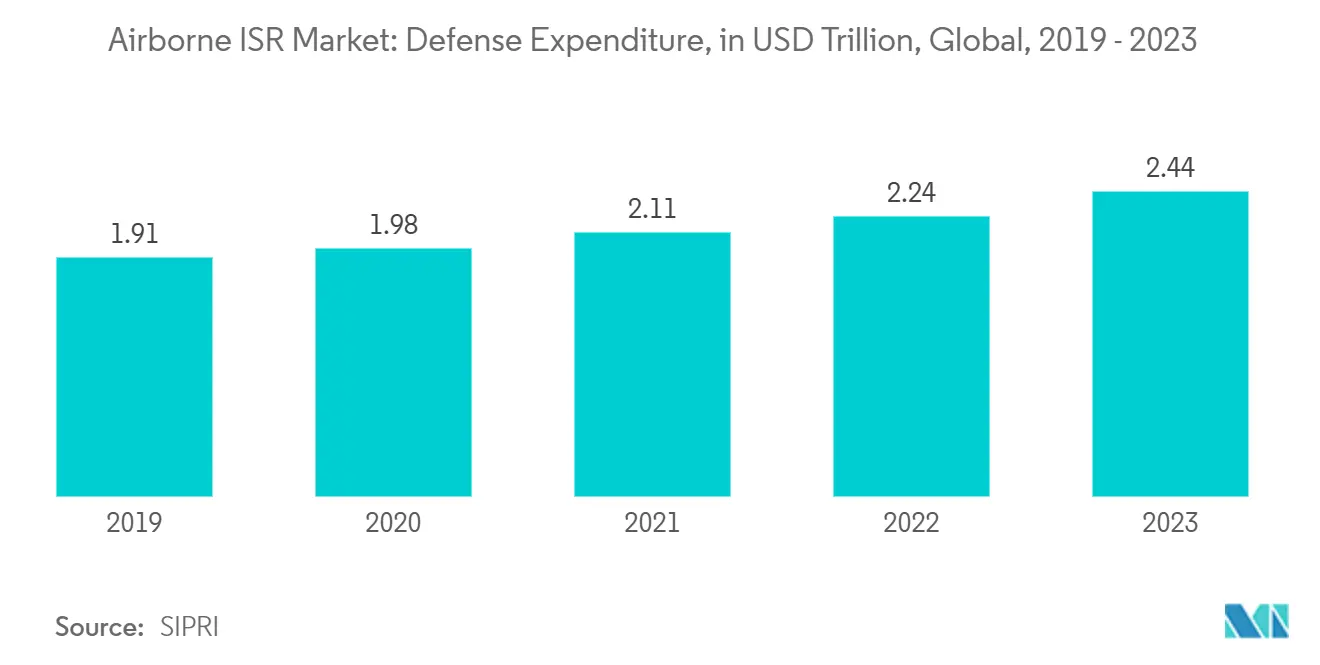
North America is Projected to Dominate the Market During the Forecast Period
North America is set to dominate the market, driven by a surge in airborne ISR demand in the United States. This demand spike is linked to a mix of factors: escalating global conflicts, heightened geopolitical tensions, the looming threat of terrorism, and the evolving capabilities of potential adversaries. In response, the US government has significantly invested in advanced technological platforms to strengthen its defense. Highlighting this commitment, the US military's defense spending hit USD 916 billion in 2023, marking a 2.3% rise from the previous year.
As threats from nations like Russia and China intensify, the US is sharpening its focus on electronic warfare. With its bolstered military budget, the US Department of Defense (DoD) is not just reinforcing but also modernizing the nation's regional defense forces. In November 2024, the US Department of Defense (D0D) unveiled "Project Maven 2.0", an initiative aimed at deepening AI's role in ISR functions. Targeting platforms like the RQ-4 Global Hawk, the project emphasizes automated target identification and threat assessment. Set to be fully operational by 2026, these innovations promise a marked boost in ISR mission effectiveness.
Furthermore, in December 2024, the US Air Force deployed upgraded MQ-9 Reaper drones, outfitted with advanced radar and electronic intelligence (ELINT) systems, to monitor Chinese naval maneuvers in the South China Sea. This operation yielded critical insights into maritime routes and naval exercises, bolstering the US stance and countering China's regional assertiveness. These strategic moves are expected to propel the region's market growth in the coming years.
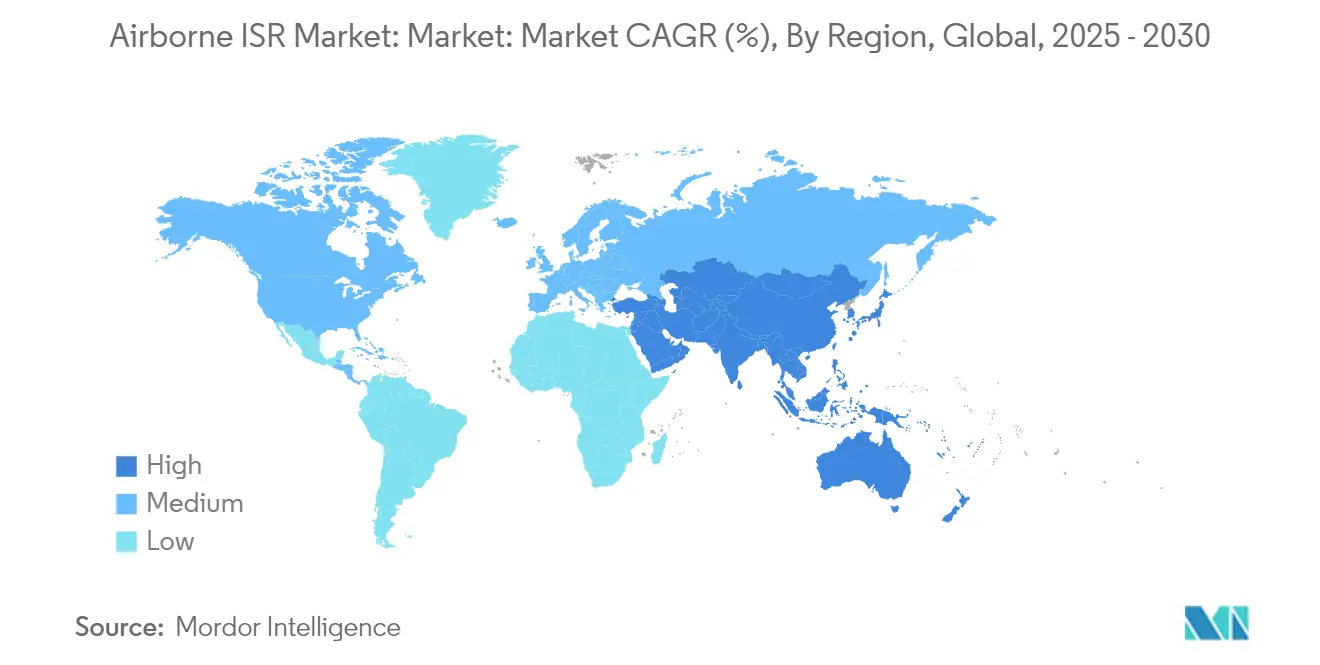
Competitive Landscape
The airborne ISR market is semi-consolidated and characterized by a few players, each developing platforms and subsystems for various armed forces. Key players in the market include Airbus SE, Northrop Grumman Corporation, Leidos Holdings, Inc., Leonardo S.p.A., and Thales Group.
Local entities frequently team up with major players on regional projects, crafting specialized subsystems for local defense forces. Competition among vendors hinges on their in-house manufacturing, global presence, product diversity, R&D investments, and client portfolios. To succeed in this competitive arena, vendors are tasked with providing advanced systems to airborne ISR integrators. Numerous defense OEMs are now integrating third-party EO/IR (electro-optical/infrared) equipment into their platforms, a strategy designed to curtail R&D costs linked to system integration across various platforms.
Airborne ISR Industry Leaders
-
Northrop Grumman Corporation
-
Airbus SE
-
Leonardo S.p.A.
-
Leidos Holdings, Inc.
-
Thales Group
- *Disclaimer: Major Players sorted in no particular order
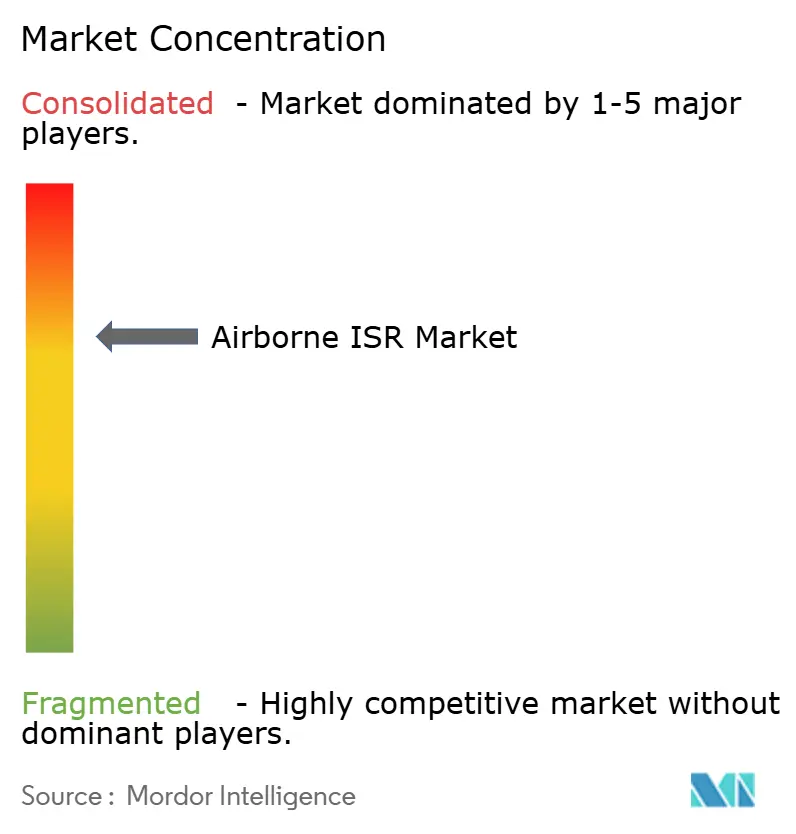
Recent Industry Developments
- February 2025: NATO placed an order with Saab AB for its Air Command and Control System, 9AIR C4I. The contract is valued at around SEK 250 million, with deliveries set to commence in 2025.
- January 2025: Teledyne Technologies Incorporated clinched a five-year contract worth USD 74.2 million. Under this agreement, Teledyne FLIR Defense is set to deliver over 125 Electro-Optic Sensor System-Modernized (ESS-M) platforms to the US Coast Guard (USCG), intended for rotary wing aircraft such as the MH-60 and MH-65.
Global Airborne ISR Market Report Scope
The Airborne ISR (Intelligence, Surveillance, and Reconnaissance) market centers on aerial platforms, including both manned aircraft and drones. These platforms are outfitted with cutting-edge technologies designed to gather, process, and relay data vital for security, defense, and tactical operations. Integral to this market are high-resolution sensors, cameras, radar systems, and advanced communication and electronic warfare systems, all seamlessly integrated into various aerial vehicles.
The applications are vast: from military and defense monitoring and battlefield management to homeland security's border and anti-smuggling operations, environmental monitoring, and even search and rescue missions. The primary users span defense forces, government agencies, and commercial entities.
The airborne ISR market is segmented by type, application, and geography. By type, the market is divided into manned and unmanned. By application, the market is segmented into maritime patrol, airborne ground surveillance (AGS), airborne early warnings (AEW), and signals intelligence (SIGINT). Also, the report covers the market sizes and forecasts for the airborne ISR market in major countries across different regions. For each segment, the market sizes and forecasts are provided in terms of value (USD).
| Manned |
| Unmanned |
| Maritime Patrol |
| Airborne Ground Surveillance (AGS) |
| Airborne Early Warnings (AEW) |
| Signals Intelligence (SIGINT) |
| North America | United States |
| Canada | |
| Europe | United Kingdom |
| France | |
| Germany | |
| Russia | |
| Rest of Europe | |
| Asia-Pacific | China |
| India | |
| Japan | |
| South Korea | |
| Rest of Asia-Pacific | |
| Latin America | Brazil |
| Rest of Latin America | |
| Middle East and Africa | Saudi Arabia |
| United Arab Emirates | |
| Rest of Middle East and Africa |
| Type | Manned | |
| Unmanned | ||
| Application | Maritime Patrol | |
| Airborne Ground Surveillance (AGS) | ||
| Airborne Early Warnings (AEW) | ||
| Signals Intelligence (SIGINT) | ||
| Geography | North America | United States |
| Canada | ||
| Europe | United Kingdom | |
| France | ||
| Germany | ||
| Russia | ||
| Rest of Europe | ||
| Asia-Pacific | China | |
| India | ||
| Japan | ||
| South Korea | ||
| Rest of Asia-Pacific | ||
| Latin America | Brazil | |
| Rest of Latin America | ||
| Middle East and Africa | Saudi Arabia | |
| United Arab Emirates | ||
| Rest of Middle East and Africa | ||
Key Questions Answered in the Report
How big is the Airborne ISR Market?
The Airborne ISR Market size is expected to reach USD 10.84 billion in 2025 and grow at a CAGR of 6.73% to reach USD 15.01 billion by 2030.
What is the current Airborne ISR Market size?
In 2025, the Airborne ISR Market size is expected to reach USD 10.84 billion.
Who are the key players in Airborne ISR Market?
Northrop Grumman Corporation, Airbus SE, Leonardo S.p.A., Leidos Holdings, Inc. and Thales Group are the major companies operating in the Airborne ISR Market.
Which is the fastest growing region in Airborne ISR Market?
Asia Pacific is estimated to grow at the highest CAGR over the forecast period (2025-2030).
Which region has the biggest share in Airborne ISR Market?
In 2025, the North America accounts for the largest market share in Airborne ISR Market.
What years does this Airborne ISR Market cover, and what was the market size in 2024?
In 2024, the Airborne ISR Market size was estimated at USD 10.11 billion. The report covers the Airborne ISR Market historical market size for years: 2020, 2021, 2022, 2023 and 2024. The report also forecasts the Airborne ISR Market size for years: 2025, 2026, 2027, 2028, 2029 and 2030.
Page last updated on:
Airborne ISR Market Report
Statistics for the 2025 Airborne ISR market share, size and revenue growth rate, created by Mordor Intelligence™ Industry Reports. Airborne ISR analysis includes a market forecast outlook for 2025 to 2030 and historical overview. Get a sample of this industry analysis as a free report PDF download.
